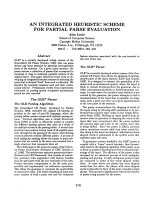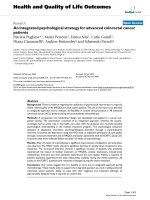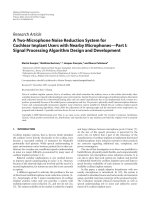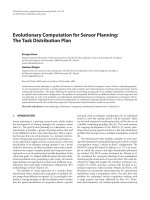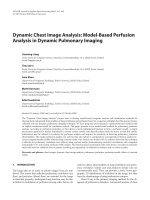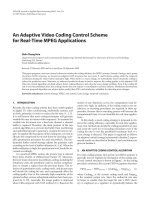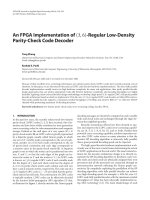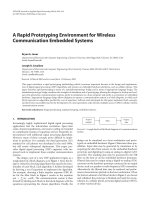an-integrated-modular-laboratory-for-analog-electronics-applied-signal-processing-control-systems-and-electronic-communication
Bạn đang xem bản rút gọn của tài liệu. Xem và tải ngay bản đầy đủ của tài liệu tại đây (134.73 KB, 8 trang )
Section 2648
An Integrated Modular Laboratory for
Analog Electronics, Applied Signal Processing, Control Systems
and Electronic Communication
Chih-Ping Yeh, Radian G. Belu
Division of Engineering Technology
Wayne State University,
Detroit, MI 48202
Introduction:
The undergraduate EE or EET students are required to take courses in several knowledge
areas, such as circuit analysis, analog and digital electronics, power electronics, control systems,
communications and signal processing, etc. The current paradigm in the course instruction
builds on a lecture prerequisite structure but ignores the need for a laboratory prerequisite
structure and integration. The laboratory for each individual course is designed to reinforce
basic concepts but typically has no larger purpose in the curriculum such as logically connecting
to laboratory works completed in earlier or future courses. Since laboratory time is short and
new concepts must be emphasized, instructors are forced to use oversimplified set-ups for
experiments. As a result, students complete laboratory exercises in these courses without
realizing that they are all contributing to the development of truly integrated systems used in the
modern industrial environment. This type of “isolated learning” is no longer acceptable as
nowadays the industry demands engineers not only with a broad set of technical skills, but also a
comprehension of the diverse practical applications of engineering concepts. Engineering and
Engineering Technology education must provide integrated experience at the undergraduate level
to fulfill the expectations of the industry1-3.
“Proceedings of the 2004 American Society for Engineering
Education Annual Conference &
1
Exposition Copyright © 2004, American Society for Engineering”
Page 9.188.1
This paper describes an on-going project to develop a multipurpose laboratory that can be
used for multiple Electrical/Electronic Engineering Technology (EET) courses in the Division of
Engineering Technology (DET) at Wayne State University (WSU). The development aims to
provide an integrative experience at the undergraduate level to help students better comprehend
the conceptual relationship among various engineering subjects and the applications of these
engineering concepts in practical integrated systems used in industry. Specifically, we have
planned to develop five laboratory modules that can be concurrently used for four upper division
EET courses: Analog Electronics (EET3180), Applied Signal Processing (EET3300), Control
Systems (EET4200) and Electronic Communication (EET4400). Each laboratory module will be
comprised of hands-on experiments and computer simulations based upon a practical system,
such as PID motor control system or audio signal modulation system. The students will use the
same laboratory modules, but study different facets of the systems in different courses.
The Multipurpose Laboratory:
This idea of the multipurpose laboratory is motivated by the successful examples of the
multipurpose/multidisciplinary laboratories developed in other universities4-9. A number of these
works were supported by the National Science Foundation DUE CCLI Grants: The School of
Engineering and Technology at Lake Superior State University has developed an Integrated
System Engineering Laboratory that houses vertically integrated laboratory exercises for twelve
courses from three different curricula10, 11. The laboratory experiments are built upon five
integrated systems: inverted pendulum, mobile robot, ball and plate unit, model train unit, model
plane unit and wind tunnel. This multipurpose laboratory is similar to the Interdisciplinary
Intelligent Mechatronics Laboratory at the Georgia Institute of Technology12. The laboratory at
Georgia Tech. is used by nine upper division and graduate courses. The College of Engineering
and Applied Science at the University of Colorado at Boulder has developed an Integrated
Teaching and Learning Laboratory shared by four departments13. The examples of experimental
modules already piloted in courses include dynamic strain of a mountain bike, musical signal
analysis, computer-controlled motor system and liquid level control system, etc. Rowan
University in New Jersey has developed a Multidisciplinary Control System Laboratory based on
the theme of system equivalence14. Another on-going NSF funded project in the ECE
Department at Rowan University is to configure three junior level courses, Communications,
Very Large Scale Integration (VLSI) and Digital Signal Processing, under a common
framework15. The primary prototype that has been developed is a laboratory manual that can be
used for the three courses.
We adapted these approaches and implemented them by developing five laboratory
modules to be used in the four upper-division EET courses as briefly described in Table 1. Each
laboratory module will be built upon a physical system that involves integration of several
subsystems as summarized in Table 2.
Table 1: Brief Description of Target Courses
Course
EET 3180 Analog
Electronics
EET 3300 Applied Signal
Processing
EET 4200 Control Systems
“Proceedings of the 2004 American Society for Engineering
2 Education Annual Conference & Exposition Copyright
© 2004, American Society for Engineering”
Page 9.188.2
EET 4400 Electronic
Communications
Description
Operational amplifier; adder, comparator, integrator and
differentiator circuits; single and multiple input amplifier; mixer;
low-pass, high-pass and band-pass filters; signal generators
Frequency and impulse responses, Fourier Transform, spectrum
analysis, Signal to Noise Ratio, A/D and D/A conversions, sampling
theorem, filtering and digital signal processing
Transfer functions, transient responses, feedback control system,
stability, Root Locus method; steady-state error, Proportional,
Integral and Derivative controllers, digital control systems
Communication theories and systems, noise, signal-to-noise ratio,
filtering of signals, impedance matching networks, amplitude
modulation, angular modulation and pulse modulation, antenna
impedance matching
Table 2: The Proposed Laboratory Modules
Module
PID Speed and Position Control
System
Audio Signal Amplitude
Modulation (AM) System
An On-Off Temperature Control
System
Voice Commanded Robotic
System
Pressure Control of a Pneumatic
System
Components
• DC motor
• PID control circuits (proportional,
integral, derivative amplifiers)
• Adder circuit (multi-input amplifier)
• Low-pass filter
• Tachometer
• Signal digitizer
• Audio mixer
• Analog multiplier (AD633)
• Audio amplifier and band-pass filters
• Audio output device
• Thermocouple/ IC Temperature Sensor
• Comparator circuit
• Bridge and instrumentation amplifiers
• Electronic switch
• Voice recognition processor (MSM6679)
• Audio signal digitizer, A/D converter
• Audio amplifiers and filters
• Stepper motors
• Pressure transducers
• Conditioning circuits
• Differential amplifiers, instrumentation
amplifiers, bridge amplifiers
• Low-pass and band-pass filters
The Laboratory Modules:
Each laboratory module includes a set of hands-on experiments and computer simulations
that can be used in different courses. Students use the same laboratory module, but study
different facets of it in different courses. Table 3 summarizes the hands-on experiments that will
be conducted using each module.
“Proceedings of the 2004 American Society for Engineering
3 Education Annual Conference & Exposition Copyright
© 2004, American Society for Engineering”
Page 9.188.3
These experiments are designed to emphasize, not only the practical applications of the
engineering concepts, but also the integrated nature of modern systems used in industry. For
example, using the PID Speed and Position Control System module, students will use the
amplifier, filter, integrator and differentiator circuit designed in EET3180 (Analog Electronics)
to carry out PID speed and position controls of a DC motor discussed in EET4200 (Control
Systems); using the Audio Signal Amplitude Modulation (AM) System module, students will
apply the multiplier circuit designed in EET3180 and the sampling theorem learned on EET3300
(Applied Signal Processing) to carry out amplitude modulation of audio signals learned in
EET4400 (Electronic Communication). Students can record and analyze their own voices using
MATLAB Signal Processing Toolbox and Communication Toolbox. The analysis further helps
students to visualize the concept of speech pattern recognition applied in the Voice Commanded
Robotic System module.
Table 3: Hands-on Experiments to be conducted using the Modules
Modules
Courses and Experiments
EET3180:
• Design an adder (multiple-input amplifier) circuit
• Design of integrator and differentiator circuits.
• Design of low-pass filter.
EET4200:
• Transient responses of closed-loop control system
• Proportional speed and position controls
• Proportional plus integral speed control
• Proportional plus integral plus derivative position control
EET3300:
• Signal sampling and A/D conversion
• Low-pass filtering and noise reduction
• Digital signal processing
EET3180:
An On-Off
• Design of comparator circuit.
Temperature Control • Design of an electronic switch circuit.
System
• Temperature-to-voltage converter circuit.
EET3300:
• Introduction to LabVIEW programming
• Signal sampling and A/D conversion
• Implementation of a digital control system
EET4200:
• Characteristics of closed-loop control system
• Improving transient responses by PD controller
EET3180:
Audio Signal
• Design of audio mixer and multiplier circuit.
Amplitude
• Design of an audio amplifier.
Modulation (AM)
• Design of low-pass and band-pass filters.
System
EET3300:
• Spectrum analysis of audio signals
• Sampling theorem and audio signal sampling
• Filtering and noise reduction
• Implementation of FIP and IIR filters in LabVIEW.
EET4400:
• Amplitude modulation, waveform measurements.
• AM spectral analysis and AM detectors
• SSB modulators and demodulators.
PID Speed and
Position Control
System
“Proceedings of the 2004 American Society for Engineering
4 Education Annual Conference & Exposition Copyright
© 2004, American Society for Engineering”
Page 9.188.4
Table continues in Next Page
Table 3: Hands-on Experiments to be conducted using the Modules (Continue)
Modules
Courses and Experiments
EET3180:
• Design of band-pass filters
• Design of signal generator and oscillator circuits
• Design of multiple-input amplifiers using op-amp. .
EET3300:
• Signal sampling and noise reduction
• Implementation of digital filters using LabVIEW
EET4400:
• Signals in the time and frequency domain.
• Spectral analysis of audio signals
• Signal sampling and noise reduction
EET3180:
Pressure Control of a • Design of comparator circuit using op-amps.
Pneumatic System
• Design of multiple-input amplifiers using op-amp.
• Signal condition circuits: differential amplifiers,
instrumentation amplifiers; bridge amplifiers
EET3300:
• Sampling modes, real and equivalent time sampling.
• Signal reconstruction,
• Signal filtering
EET4200:
• Characteristics of a feedback control systems
• Control algorithm, hysteresis
Voice Commanded
Robotic System
Each experiment package includes three components: theoretical background,
questionnaires and laboratory menu. The theoretical section is provided for the students to study
the theories and engineering concepts applied in the experiment. Questionnaires help to enhance
students’ comprehension of the theories studied. Students must first answer the concept
questions before they can download the laboratory menu for each experiment. This approach has
been applied in the engineering and engineering technology programs in other institutes, such as
University of Missouri and NSF funded Greenfield/Focus: Hope.
Development of the Modules:
Among the four targeted courses, EET3180 and EET4200 have existing laboratory setups
for hands-on experiments, but EET3300 and EET4400 have only computer-simulation exercises.
Therefore, the development involves integrating the existing laboratory experiments for
EET3180 and EET4200 into the five modules and, at the same time, developing new hands-on
experiments for EET3300 and EET4400. Currently, only the first two modules are being used
in the classes.
“Proceedings of the 2004 American Society for Engineering
5 Education Annual Conference & Exposition Copyright
© 2004, American Society for Engineering”
Page 9.188.5
The laboratory modules are PC-based. LabVIEW data acquisition tools and virtual
instrument are used for signal generation, display and processing. MATLAB Simulink and
Control, Signal Processing Toolbox and Communication Toolbox are the primary software used
for computer simulation. Currently, we have six workstations set up in our Control Lab. We
have planned to apply NSF funds to expand this multipurpose laboratory into 16 workstations,
consisting of eight stations each in Analog Circuit Lab and Control Lab.
The development of the laboratory modules is partially due to the results of the WSU
funded Undergraduate Research Projects as listed in the Acknowledgement section. We have
introduced this project in the Senior Project class (ET4999) each semester and encourage senior
students and MSET students to participate in the development. As mentioned above, the
development of this multipurpose laboratory is an on-going project. We will continue to develop
and modify the planned laboratory modules. In the future, we will extend this multipurpose
laboratory for other EET courses, such as EET3010 (Instrumentation and Measurement),
EET3150 (Network Analysis) and EET3150 (Electric Machines). The long-term goal is to use
this prototype development to develop a multidisciplinary laboratory shared by other programs in
WSU-DET. An example of such a laboratory would be one shared among MCT3410
(Kinematics and Dynamics Machines) and MCT3180 (Fluid Mechanics) in the MCT program
and EET4200 (Control Systems) and EET3010 (Instrumentation and Measurement) in the EET
program.
Impact and Significance
The impact of this multipurpose laboratory on engineering technology education at WSU is
realized through the integration of practical systems, real-time data acquisition, virtual
instrument signal processing, and computer-aided simulation and analysis components to the
laboratory. In the Analog Electronics (EET3180) class, students no longer design stand-alone
amplifiers or filters testing sinusoidal signals from a signal generator. Instead, they design and
test the circuits on a practical system, such as PID controller or AM modulator. In the Control
Systems (EET4200) class, control systems are no longer just some abstract “mathematical
concepts” and a set of “block diagrams” on paper. Instead, students will actually implement the
concepts and realize the block diagrams by the circuits they learned and designed in other
classes. These integrated experiences enable students to better comprehend the conceptual
relationship of analog electronics, control system, signal processing and electronic
communication theories. Further, the laboratory setup provides students the opportunity to work
with the modern data acquisition tools and computer software similar to those that exist in the
industry. These results match with our goal for engineering technology education to continue
equip superior hands-on experiences in the emerging engineering technologists.
Conclusion
“Proceedings of the 2004 American Society for Engineering
6 Education Annual Conference & Exposition Copyright
© 2004, American Society for Engineering”
Page 9.188.6
This paper describes the on-going project for developing a multipurpose laboratory that can
be concurrently used by four upper division EET courses in the WSU-DET. The objectives,
target courses, laboratory modules, planned hands-on experiments and the development
procedures of the project are explained. The project has been partially supported by the WSU
Undergraduate Research Program. We will continue to involve students in the design,
development and improvement of the laboratory modules. Although only two modules are
currently used in the classes, the impact has been significant. In the future, we will expand this
multipurpose laboratory for more EET courses, and eventually lead to the development of a
multidisciplinary laboratory shared by other programs in the Division. We will post the
laboratory modules on the WSU-DET Website to share our ideas with other institutions in the
future.
Acknowledgement
The authors would like to thank the WSU Undergraduate Research Council for the supports of
the following undergraduate research projects:
1.
2.
3.
4.
5.
“Computer-based Data Acquisition for Audio Equipment Standardization”,
“Development of Calibration Test Bench for Electronic Components”,
“Development of PC-Based Discrete PID Controller for Servo Motor Control”,
“Implementation of Lock-In Amplifier Using Virtual Instrument”,
“Development of Web-Based Discrete PID Controller for Servo Motor Control”,
Bibliography
“Proceedings of the 2004 American Society for Engineering
7 Education Annual Conference & Exposition Copyright
© 2004, American Society for Engineering”
Page 9.188.7
1. Lau, A.S., “An Innovative Multidisciplinary Course for Engineering Technology”, Proceedings of 2000 ASEE
Annual Conference, Session 2344, June 18-21, 2000.
2. Denton, D.D., “Engineering Education for the 21St Century: Challenges and Opportunities”, J. of Engineering
Education, January 1998, pp. 19-22.
3. Hall W.L. and Z.J. Cendes – Introducing real world design problems into undergraduate electromagnetic
curriculum, IEEE Trans. on Educ., pp. 279-284, vol. 36, no. 2, 1993.
4. DeLyser R.R., Wilson J.C. and R.W. Quine, “A Novel Multidisciplinary Course: Measurment and Automated
Data Acquisition”, Proceedings 29th ASEE/IEEE Frontiers in Education Conf., San Juan, Puerto Rico, 1999, pp.
12d3-1-12d3-6.
5. Waver J.M. and S. Das, “Overhaul of an Undergraduate Mechanical Measurements Laboratory”, Proceedings 29th
ASEE/IEEE in Frontiers in Education Conference, San Juan, Puerto Rico, 1999, pp. 13d6-1- 13d6-5.
6. G. Beauchamp-Baez and L. V. Melendez-Gonzalez, “A Design Project Approach to Teach Electronic
Instrumentation”, Proceedings 29th ASEE/IEEE in Frontiers in Education Conference, San Juan, Puerto Rico, 1999,
pp. 12d3-10- 2d3-17.
7. Joseph J.D.C. and S.K. Julien - Laboratory exercise and modular design, International J. of El. Eng. Education,
pp. 316-332, vol. 37, no. 4, 1996.
8. Duderstadt, J., “Transforming the University to serve the Digital Age”, Cause/Effect Vol. 20, No. 4, Winter
1997-1998, pp. 21-32.
9. Fernandez-Iglesias M.J. et. al. – “An undergraduate computer communications laboratory oriented towards
industry”, International J. of El. Eng. Education, pp. 147-157, vol. 37, no. 3, 1996.
10. Mahajan, A., Walworth, M. and McDonald D., “The Integrated System Engineering Laboratory - An Innovative
Approach to Vertical Integration using Modern Instrumentation”, Proceedings of 2001 ASEE Annual Conference, ,
Session 2259, June 24-27, 2001
11. Mahajan, A., “An Inovative Integrated Learning Laboratory Environment”, Proceedings of 2000 ASEE ASEE
Conference, Session 1559, June 18-21, 2000..
12. Arkin R.C. et al., “The Development of a Shared Interdisciplinary Intelligent Mechatronics Lab.”, ASEE J. of
Engineering Education, Vol. 86, April !997, pp.113-118.
13. Carlson, L., Peterson, L., Lund W. & Schwartz T., “Facilitating Interdisciplinary Hands-on Learning using
LabStations”, Proceedings of 2000 ASEE ASEE Conference, Session 2659, June 18-21, 2000.
14. Ramachandran R.P., Farrell, S. & Mariappan, J., “A Multidisciplinary Control System Laboratory”,
/>
15. Ramachandran L.M., Head, S. Chin, S.H., Schmalzel, J.L. & Mandayam, S.A., “Communication, Signal
Processing and VLSI: Education Under a Common Framework”,
/>
CHIH-PING YEH
Chih-Ping P Yeh received the B.S. degree in Electronic Engineering from Taiwan, the M.S.
degree in Biomedical Engineering from Northwestern University at Evanston, IL, the M.S. and
Ph.D. degrees in Electrical Engineering from Texas A&M University at College Station, TX.
Dr. Yeh is the Interim Chair of WSU-DET in Detroit, Michigan.
RADIAN BELU
Radian Belu hold a M.S. degree in Physics from the University of Bucharest, a M.S. degree in
Electronic and Telecommunication and a Ph.D. degree in Power Engineering from Polytechnic
University of Bucharest and another Ph.D. degree in Physics from University of Western
Ontario, London, Canada. Dr. Belu is an Assistant Professor in WSU-DET.
Page 9.188.8
“Proceedings of the 2004 American Society for Engineering
8 Education Annual Conference & Exposition Copyright
© 2004, American Society for Engineering”
